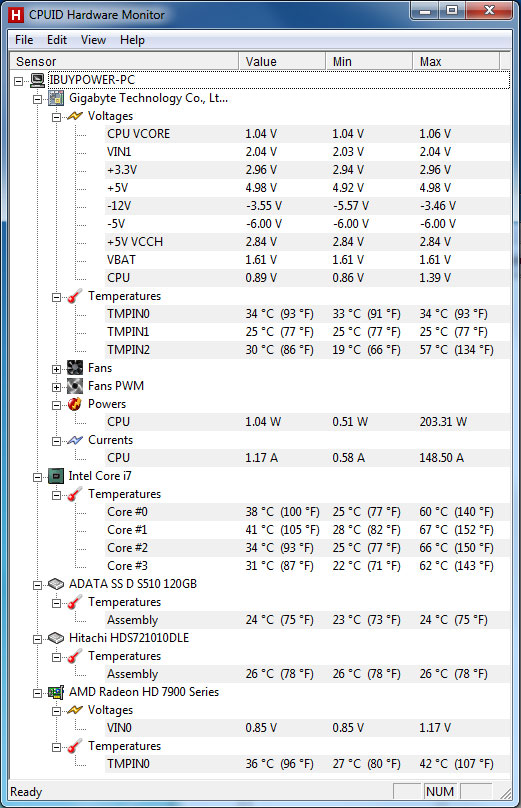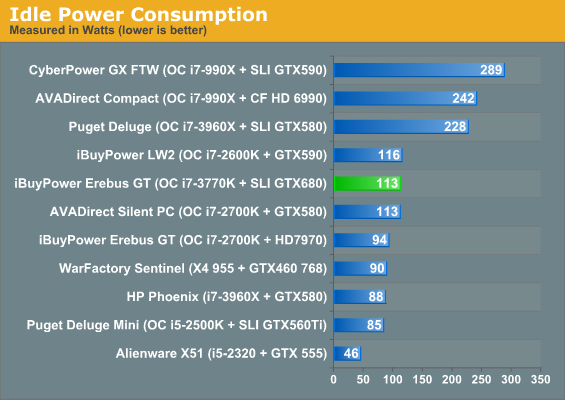iBUYPOWER Erebus GT Review: Ivy Bridge and NVIDIA's GeForce GTX 680 in SLI
by Dustin Sklavos on April 27, 2012 2:00 AM ESTBuild, Heat, and Noise
Given that the iBUYPOWER Erebus GT we have for review now is essentially identical in terms of build quality to the one we reviewed a month-and-a-half ago, there isn't a whole lot to update on. Build quality on this review unit was excellent, period, and the components iBUYPOWER chose were all solid, name brand selections. If anything, I think part of it might have been over-engineered.
Where things get interesting is when we look at system thermals and power draw. We've heard that Ivy Bridge runs hotter than Sandy Bridge does, and I can confirm those findings by comparing the thermal readings from our Sandy Bridge-based Erebus GT against our Ivy Bridge-based Erebus GT.

Intel Core i7-2700K-based Erebus GT

Intel Core i7-3770K-based Erebus GT
First, it's pretty obvious the water-cooling loop is doing its job on the video cards, and by doing so they give NVIDIA's GPU Boost a lot of thermal leeway. iBUYPOWER didn't overclock the GTX 680s in the Erebus GT, but odds are good you could probably eke out even more performance if you were somehow not satisfied with two GTX 680s in SLI. Second, the i7-3770K definitely runs hotter than the i7-2700K. Not by a tremendous degree, but there's a difference. Keep in mind that the ambient temperature in the room when testing the i7-3770K was closer to 21C, and definitely lower than it was when testing the i7-2700K.
Something to consider is that Ivy Bridge is a smaller chip than Sandy Bridge, but while it's more power efficient (see below), it's also more power dense. If we just use the base TDP, Sandy Bridge 4C is 95W in a 216mm2 die, for a power density of 0.44W/mm2. Ivy Bridge 4C by comparison is 77W in 160mm2, or 0.48W/mm2. That's only a 9% increase, but given how IVB reacts to overclocking and voltage, it's not too surprising that maximum reasonable overclocks are down for this first round of 22nm parts.
I'll say I'm not sure that HWMonitor's wattage readings are 100% accurate, either; the 203W it reports for the overclocked i7-2700K doesn't line up with our own power consumption test results, while HWMonitor reported between 50W and 70W for the i7-3770K. That's a little more believable given how frugal this configuration was with power in our test results, but still seems on the low side.
In terms of noise, it seems like someone heard my complaint about the fans in the first Erebus GT because this one comes with a fan controller. iBUYPOWER employs NZXT's six-channel analog fan controller, and it's very easy to adjust fan speeds to strike a good balance between noise and performance. I use the same controller in my own personal desktop.
Power Consumption
Where things get really exciting, actually, is in how much power this Erebus GT pulls from the wall. Keep in mind we're still dealing with a custom liquid-cooling loop, but thankfully iBUYPOWER applies an offset voltage that allows the system to idle properly.


Power consumption is, frankly, outstanding. Intel's i7-3770K, at least overclocked where it is in this system, still sips power, and the pair of GTX 680s are able to provide performance comparable to or better than a pair of GTX 590s at roughly half the power draw.
As a result, I honestly feel like the 1.2kW PSU is absolute overkill for the Erebus GT. It simply doesn't need it; a 750W unit would've done the job with plenty of headroom to spare. This configuration is incredibly efficient for the performance you get, so there's no need to waste the extra money on a huge power supply.


_thumb.jpg)
_thumb.jpg)
_thumb.jpg)
_thumb.jpg)
_thumb.jpg)
_thumb.jpg)








64 Comments
View All Comments
JarredWalton - Friday, April 27, 2012 - link
Based on previous pricing by iBUYPOWER, I'd guess they'll end up charging around $3000. However, we can't really print that since it's just a guess. :-pawall13 - Friday, April 27, 2012 - link
Would be nice to see noise measurements for this water cooled setup. Seems to me that it would be an important consideration for a potential buyer compared to building their own (more likely air-cooled) setup.ewood - Friday, April 27, 2012 - link
Normally I would overlook this little slip up but it is the third time I have heard an anandtech article refer to Lynnfield as a tick when in fact it is a tock. It did not use a new fab process and it did employ a new architecture. Lynnfield was a tock. Get it right, you're a hardware site.JarredWalton - Friday, April 27, 2012 - link
Sorry, you're right. I screwed up and looked at Lynnfield. The article has been adjusted, but in my above comment, if you just replace "Lynnfield" with "Clarkdale" not a whole lot changes. Clarkdale was very underwhelming, and Gulftown is highly specialized. I never actually ran either one other than seeing a hex-core Gulftown stuffed into a Clevo X7200. :-\The problem is that Intel made comparisons very messy with Westmere. On the desktop we had Clarkdale (dual-core plus IGP) and Gulftown (hex-core and no IGP). On laptops we had Arrandale (basically just mobile Clarkdale). There were no mainstream quad-core Westmere parts, so you had mainstream dual-core or high-end hex-core and never the twain shall meet.
Anyway, don't feel too superior for catching the error -- try writing about technology and code names for a few years and I can pretty much guarantee you'll make some mistakes. Heck, just read the tech junky posts in hardware forums and even the best people make mistakes.
JarredWalton - Friday, April 27, 2012 - link
And yes, I know that Clarkdale's IGP was actually 45nm on package.web2dot0 - Friday, April 27, 2012 - link
Isn't there something fundamentally wrong with people using 1200W of power to play computer games? Considering that there is a power shortage all over California, it's pretty abusive to hoar all that juice when there are better ways to spent it.Not trying to be judgemental or anything, but there should be regulation on energy consumption for computers that are not work-related. No different than emission standards for cars and such.
UltimateKitchenUtensil - Saturday, April 28, 2012 - link
1200 W is just the power supply's capacity. If the components draw less than that (in this case, much less than that), the supply will only give them what they need. And it will do it very efficiently, since the AX-1200 is 80+ Gold.In this case, even though the power supply is rated 1200 W, the system, under load, only consumes 471 W of power. Some of it is wasted, but over 80% is used by the system.
web2dot0 - Saturday, April 28, 2012 - link
I'm sure having a 80+ Gold PSU is great, but you are still using alot of power. I'm guessing if you plan to have a SLI config, you are going to OC the CPU, and everything else.A regular PC consumes < 150W, this PC is using 471W.
I'm also guessing that people who buys these bad boys aren't exactly casual gamers, so these PCs will be under load way more often than an average PC.
Just saying ....
buzznut - Saturday, April 28, 2012 - link
Its funny, AMD comes out with a product that equals its previous efforts and its a major fail. Why do we find it so easy to forgive Intel?"I feel like a lot of us were hoping for either a bigger performance improvement or better overclocking headroom due to the new process, but what we have instead is a chip that, when pushed to its conventional limits, is essentially still only the equal of its predecessor in terms of performance."
And doesn't overclock as well. Aren't you glad you ran out and bought that Z77 board?
Obviously it has a little to do with power and efficiency. At least BD is much more capable with respect to overclocking. I am very underwhelmed.
Which is what confuses me. Ivy Bridge has been overhyped as much as bulldozer was. People really should be asking, "what happened?"
Dustin Sklavos - Saturday, April 28, 2012 - link
Ivy Bridge is still directly superior to Sandy Bridge in almost every way BUT overclocking headroom. I'm underwhelmed by Ivy Bridge, but it's much more efficient in terms of power consumption than Sandy Bridge. Before overclocking, you get slightly better performance for much less power.Bulldozer was in many ways a step BACK from Deneb and Thuban. The FX-8150 should always have at least equalled the Phenom II X6 1100T, but in certain cases it was actually slower.
That, and everyone wanted and needed Bulldozer to do well for AMD's sake, the sake of the market, the sake of the community. Nobody was really looking at Sandy Bridge and going "boy, if Intel could make this thing faster we'd all be better off."